The Kala Bhoomi Odisha Crafts Museum is one of the best modern-day museums showcasing the best of the heritage arts and crafts of Odisha. It is a must-visit destination in the city of Bhubaneshwar. You can spend a couple of hours there learning and admiring the traditional arts and crafts of Odisha.
Visit Kala Bhoomi – Odisha Crafts Museum
As a private museum on the outskirts of Bhubaneshwar city, it is home to some of the best pieces of heritage arts and crafts of the erstwhile Kalinga state.
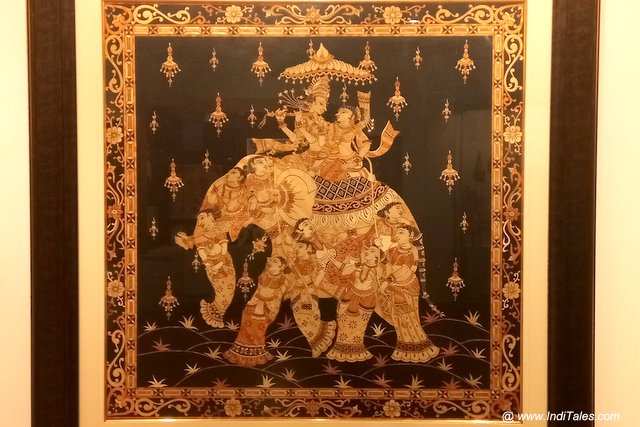
Open on all 7 days of the week, the museum visiting hours are 10 AM to 5.30 PM. The ticket counter closes 15 minutes ahead at 5.15 PM. Do note the museum is closed to visitors on a few national holidays. About 8 km south-west of the city center this museum visit can be clubbed with the Udayagiri & Khandagiri Caves visits too. They are a mere 3 km apart. It is spread over 12 acres and the local area is called Pokhariput and was inaugurated in 2018.
Camera
The first impression upon reaching the museum was noticing the beautiful campus it is housed in. Lush green and well-planned surroundings with decent parking and courteous staff help a visitor. Nevertheless as usual there are some surprising rules/systems/guidelines/regulations in such places everywhere. Like here, they do not allow visitors to carry a camera either to take photos or videos. A formal camera. However, even more surprisingly, they allow/allowed mobile phones with a camera, both to capture images and videos.
Museum Sections
The museum has an audio/video section for visitors, where one can watch several clips describing the arts and crafts of Odisha. It is very useful for visitors if you have time and curiosity to understand. The main section is of course the galleries housing the masterpieces of the artifacts showcasing the master craftsmanship from the Odisha state. The galleries are well laid out, well-lit, presented, stored, and displayed, and have their staff explain should you have questions or curiosity.
At the exit, they have a nice souvenir shop for those interested in buying authentic handicrafts, handlooms, and artifacts from the local artisans.
Handicrafts & Handlooms Galleries
The galleries in the Kala Bhoomi – Odisha Crafts Museum are divided into several heritage art forms of the state. Artifacts in this museum are predominantly about the local culture, history, heritage, Lord Jagannath trinity and Lord Krishna presented in various art/craft forms.
Miniature Paintings
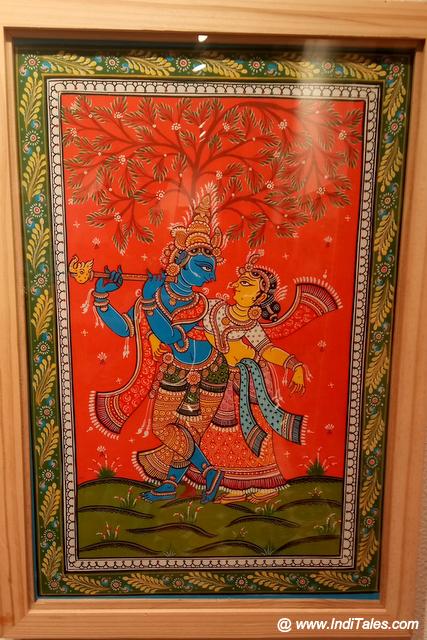
This gallery in Kala Bhoomi will take considerable time if you admire the heritage of natural dye miniature paintings that tell a lot of stories of their times. There are a few dozen of them on display. You need to pay close attention, maybe put on your spectacles to notice the fine works on display. The craftsmanship of those artisans displayed in front of you, even when they did not have a magnifier or spectacles to execute is at the least magnificent. Most of these themes are around Lord Krishna, Mahabharat, social life, and rulers of those days.
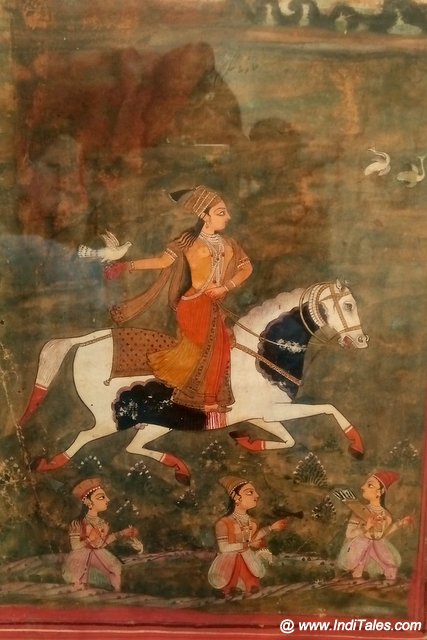
There are even hand-painted pieces that help you understand the steps of the painting process. It is amazing how natural dyes have lasted over the centuries. There can easily be over a hundred thousand such masterpieces preserved in museums across India. More are potentially lost.

Carved Wooden Door Jambs and Panels
Kala Bhoomi has preserved and put on display some of the heritage houses/building’s main wooden doors, jambs, and panels. They are beautifully carved and have stood the test of time, weather, and perhaps neglect. Today they are a reminder of the wood carving skills of yesteryears. Possibly made of the best quality wood like teak, they were built to last. That’s another value of our ancestors we seem to be royally ignoring in the 21st century.
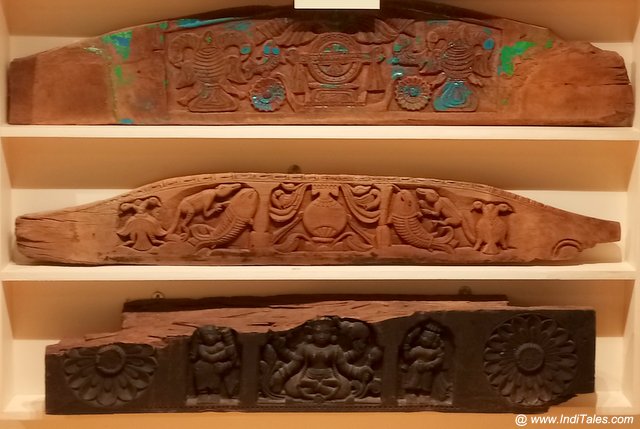
Recall having seen similar carved wooden doors/panels in your village/town/city. Try to save/preserve them in local museums.
Lac Artifacts
Lac is a natural resin produced by tiny insects wild and cultivated. These days the popularity of Lac may be limited to places like Hyderabad’s Laad Bazaar. Lac is a very useful resin, a natural ingredient used intelligently for many purposes. India is the largest producer of the Lac raw material in the world. Here in Kala Bhoomi, you can see artifacts made of Lac for decorative purposes.
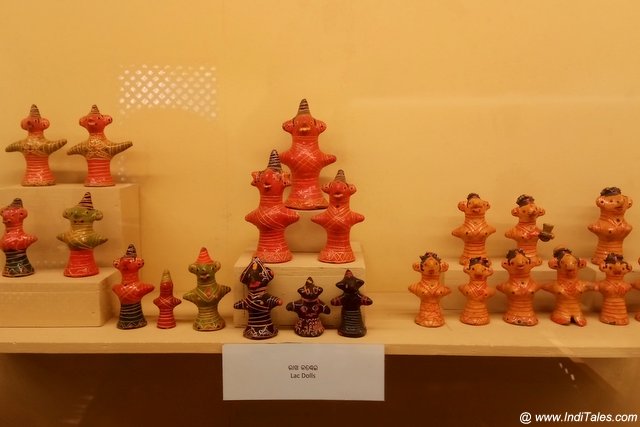
Look at these lovely Lac dolls for kids to play with or for you to decorate your home.
Silver Filigree Artifacts
Silver is a malleable metal. Who does not love silver jewelry? Cuttack, the twin city of Bhubaneswar has been a historical home to some of the finest Filigree artisans. No doubt some of the heritage masterpieces of filigree work are displayed at the museum.
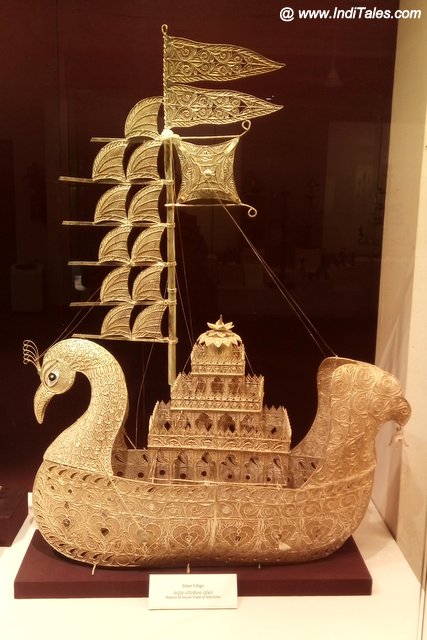
Filigree Sailing Ship, a sea-going vessel that uses sails mounted on masts to harness the power of wind and propel the vessel, designed with Peacock images on both ends, reminds us of the maritime history of the region.
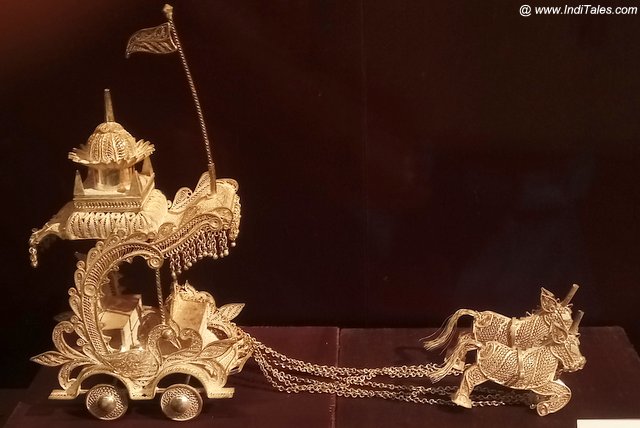
The filigree Horse Chariot masterpiece takes you to the Bhagwad Geeta from Mahabharat.
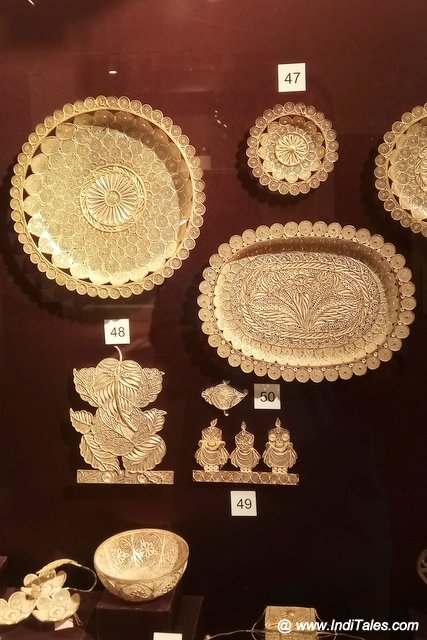
Jewelry and other, day-to-day use heritage utensils are part of the filigree artifacts on display
Painted Coconuts & Pots
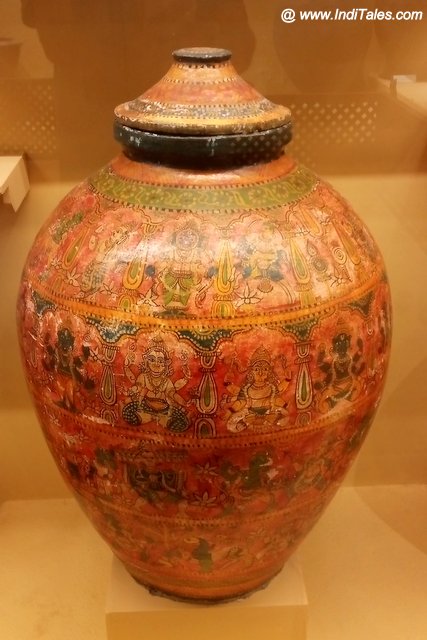
Painting skills in those days must have been practiced on whatever was easily available. Clay pots and whole dried coconut were the canvases of artisans. Such nicely painted artifacts on display at the museum must raise our curiosity about the way to learn arts and crafts.
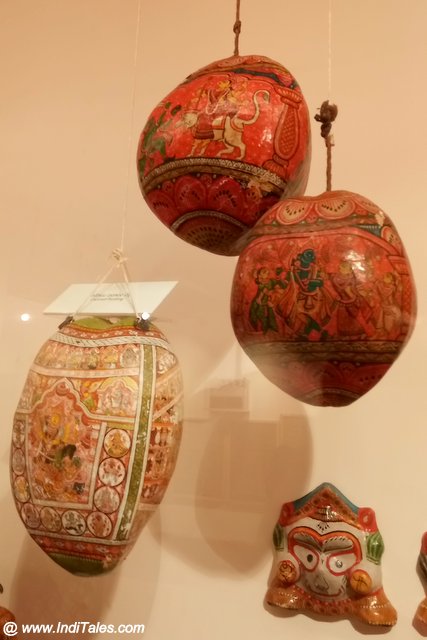
Traditional Handlooms
Odisha has some of the finest traditional handloom weaves. Probably the largest gallery in the museum. Well-known worldwide as amongst the finest handloom sarees in both silk and cotton! ‘Bandha’, ‘Ikat’, and ‘Pasapalli’ Odisha sarees have their fans globally. From ancient times, when brave Odia Sadhaba Pua or traders used to sail to South East Asia, Sri Lanka, and other countries to sell their stunning handloom merchandise.
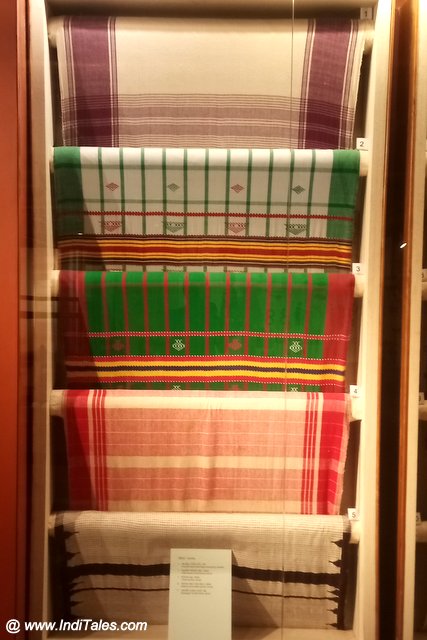
Sustainable, fashionable, handwoven, timeless, eco-friendly and so many heritage weaves showcased here!
Carved Painted Wooden Masks
Wooden masks played an important role in depicting the characters in historical plays during public performances of the last century and beyond. At Kala Bhoomi, several nicely crafted, colorfully painted carved wooden masks are on display.
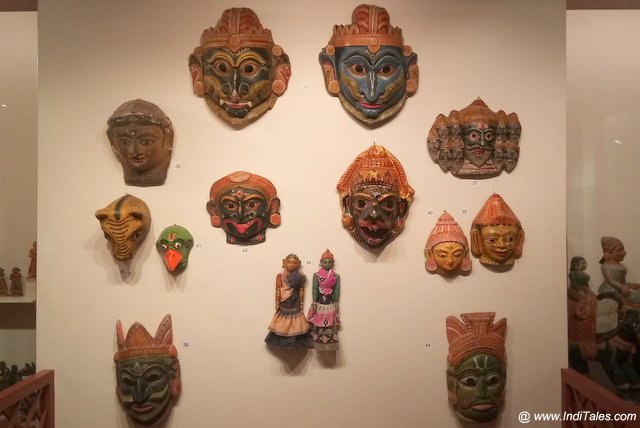
Tribal Jewelry
Odisha is home to several tribes. Their traditional silver and metallic jewelry items collection on display at the museum gives us a glimpse of their crafts. However, the Tribal Museum at Bhubaneswar has far more variety of tribal cultural artifacts.
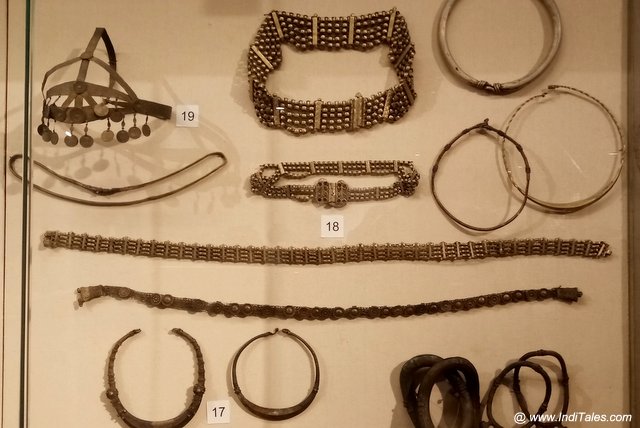
The everyday utensils on display are interesting. Some huge vessels indicate festive or community cooking practices.
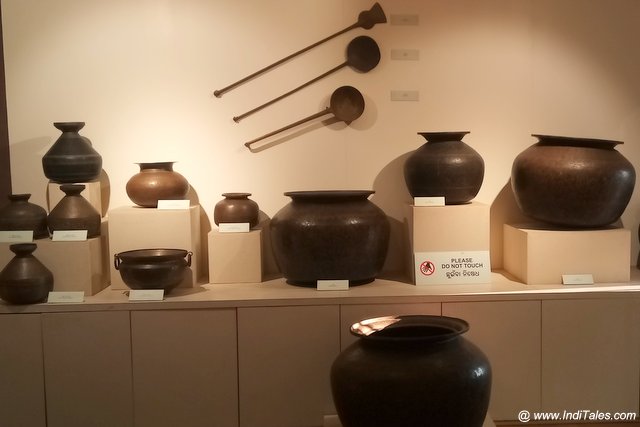
You need some time to watch keenly and go slow in the galleries. Something or the other display is going to pleasantly surprise you.
Terracotta Artifacts
How can terracotta, a far more affordable, widespread, processable material craftsmanship of those times be behind?

Yes, the museum also has some interesting artifacts made of terracotta.
Palm Leaf Etching – Pattachitra
Read our post on Raghurajpur – Pattachitra artisan village in Puri to understand the art of Pattachitra. At the museum, you can see some exquisite palm-leaf etched paintings on palm leaves.

Stone Carvings
There is perhaps no other widely and popularly known stone-carved imagery than the Konark Sun Temple. No doubt Odisha is well known for stone carving craftsmanship. As a souvenir, it is Lord Jagannath who rules the roost, though Konark Wheel and many more options can be found.

We were pleasantly surprised to see the exact replica stone-carved Konark wheels carved along the highway.
Bell Metal Crafts – Dhokra Art
This Dhokra art piece of a bull is intricately designed and the elephant faces are some of the heritage Bell Metal crafts on display in the museum.

Bell Metal is a hard alloy, a form of Bronze and Tin mostly used in making temple bells. Called Kanh locally, districts around Bhubaneshwar were well known for craftsmanship using it. Popularly known as Dhokra Art in India, the technique of hollow lost-wax casting is named after the Dhokra Damar tribes of this region including the surrounding states. Dhokra artifacts are very popular in India and abroad. This art form has been in existence for over 5000 years.

Read about Ektaal and Arts and Crafts village of Chhattisgarh and get to know about the national award winner Dhokra artist Smt Budhiarin Devi.
Sholapith Handicrafts
The cortex of the plant called Shola (Aeschynomene Aspera) also called Indian Cork grows wildly in the marshy waterlogged lands of Odisha and Bengal. It is a popular raw material for hundreds of handicraftsmen. Remember the white-colored ornamental decorations on the idol during the popular Durga Puja or the headgear of the groom & bride during Bengali weddings? The natural raw material is considered auspicious, and pure, and hence used during religious and social functions in the region.
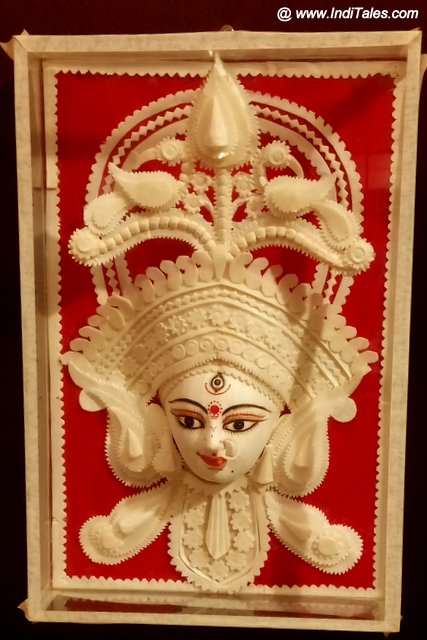
The natural source raw material is known for malleability, texture, luster, light-weight, sponginess, and biodegradability which has enabled it to be a special and popular handcrafted product. Lord Jagannath & Goddess Durga souvenirs are the most popular and well-crafted masterpieces of Sholapith. It is also a popular Bengal Souvenir.
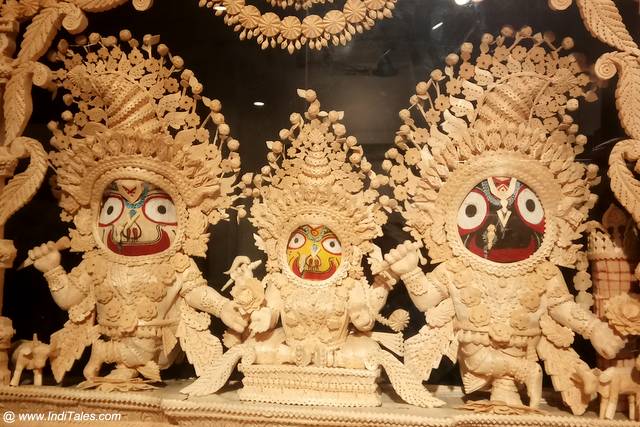
The headgear worn by Lord Jagannath trinity during the Rath Yatra to the making of boats for the Boita Bandana (Bali Yatra festival) during Kartik Purnima is when you can see a lot of Sholapith decorative items. Some of the best artifacts can be seen at Kala Bhoomi, Odisha Crafts Museum in Bhubaneshwar.
Godhi Dance Costume
On display at the museum is a couple of imitation horses made with bamboo with layers of colorful, glossy clothes to cover the entire structure up to the legs. A wooden horse face neck upwards is built into and supported by the structure. During the Ghodi dance performance, a person gets into the structure and carries it with him on foot.
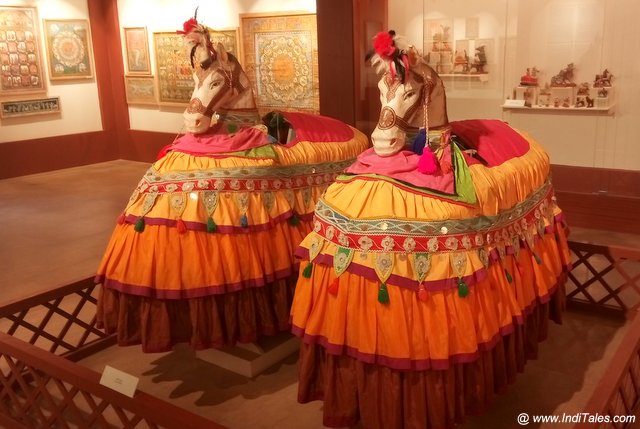
The Ghodi dance is performed during religious events/processions across the country. Some say it originated in the Kutch region of Gujarat state and then gradually spread all over India. Get a glimpse of such a performance during the annual Shigmotsav festivities in Goa, on the YouTube video posted on our channel here and here.
Travel Tips
- So if you do plan to visit, do check out their website.
- A nominal entry fee of Rs 50 is charged per adult.
- The museum has daily, one-hour-long free guided tours of the museum in multiple languages, like English, Hindi, and Odia at scheduled hours.
- They also conduct workshops on pottery and paddy crafts.
- You can easily spend an hour in the museum, admiring the heritage of Odisha. Interested in arts and crafts keep half a day to know/learn local artisanship. More so if you wish to watch the recorded programs in the auditorium.
- They also have drinking water and restroom provisions for all the visitors.






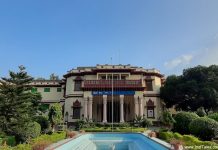







Excellent write up on craft heritage of Orissa.
Thank you Sunita Ji. There is so much to write about on India that one needs a few lifetimes.
What I’ve learnt reading this is that we have a lot of forgotten skills, techniques in our country which used to be traditional for us, however over time maybe due to time or introduction of new technologies we may have lost our own touch of skill. Places like these should be explored to learn more about the level of skill and vision of Indian communities. I’m glad reading this article I’ve learnt more about dokra art, pattachitra and others in the article
Kala Bhoomi sounds like a hidden gem for anyone interested in Odisha’s rich artistic heritage! Love the idea of immersing in traditional crafts while exploring Bhubaneshwar. Definitely adding this to my must-visit list!